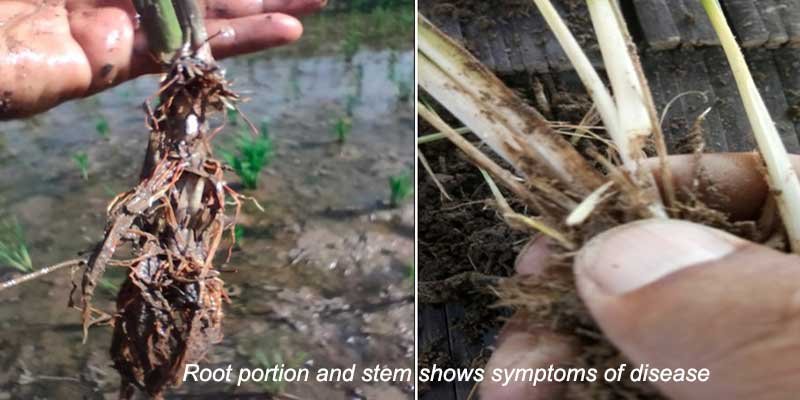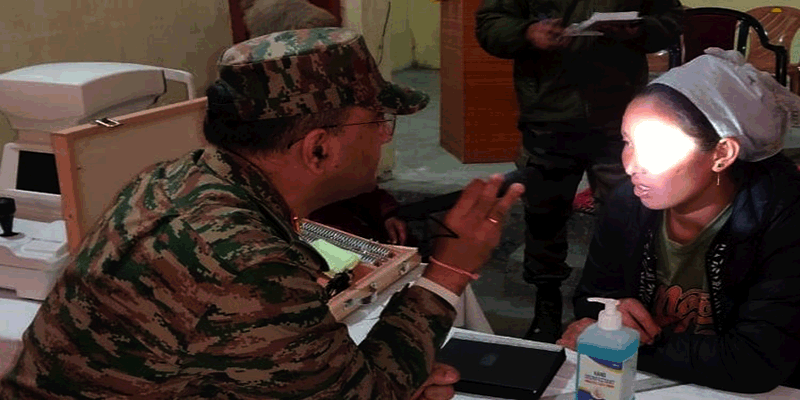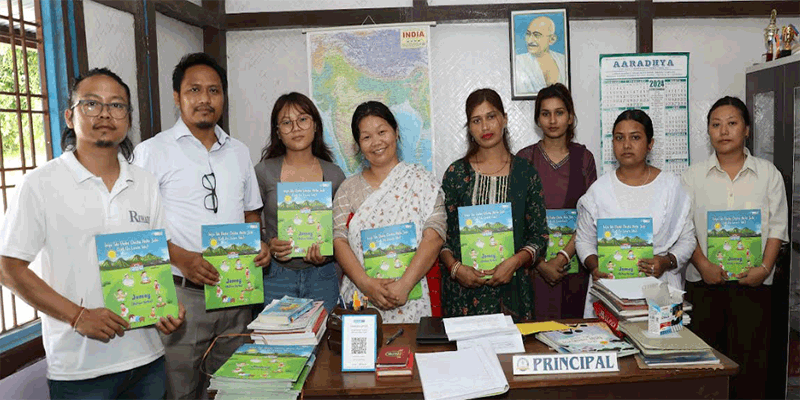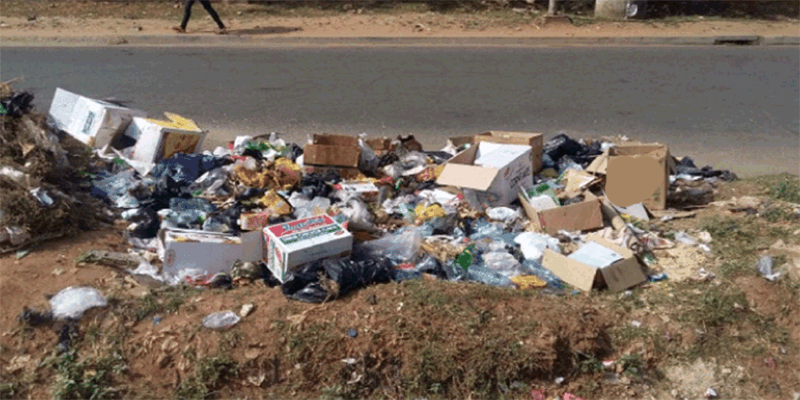Stem Rot of Rice: An emerging problem in Arunachal Pradesh

PASIGHAT- Rice (Oryza sativa L.) is one of the important staple food crops for more than 60 per cent of the world’s population. More than 90 per cent of the rice produced in the world is consumed in the Asian countries only. India is the number one country in the world in cultivating rice in an area of 43.5 million hectares with an annual production of 893.1 million tones and it ranks second to china in the production. Stem rot disease caused by Sclerotium oryzae which was earlier considered as a minor disease has now became one of the major limiting factors in rice cultivation especially in delayed transplanted conditions in all over the country. In severe cases, lodging of the crop may occur and sclerotia of the pathogen are found within the host tissues. The yield losses upto a maximum of 80 per cent in different rice cultivars has been reported by several workers form varied agro climatic regions in India and aboard.
Symptomatology
- Stem rot is a fungal disease found in rice. It causes black lesions commonly located around water level on the stem of the plant and is often first noticed around panicle initiation (PI).
- The initial disease symptoms are small, irregular black lesions on leaf sheath at the water line. Stem parts in between leaves rot and collapse.
- The disease advance stage, the lesions enlarge, penetrating the inner leaf sheath and culm and producing brownish black lesions.
- One or two internodes of the stem eventually rot and collapse (only epidermis remains intact), leading to lodging, unfilled panicles chalky grain or death of tiller.
- Dark grayish mycelium can be seen inside hollow, infected stems, with small, black sclerotia dotted over the inner surface.
- The disease manifests from panicle initiation stage but the conspicuous diagnostic symptoms are usually seen at later growth stages of crop e., from milky to grain hardening stage.
Causal organism: Stem rot disease of rice incited by Sclerotium oryzae (Perfect stage- Magnaporthe salvinii Krause and Webster.

Identification of pathogen:
The perithecia are dark, globose and embedded in outer tissues of the sheath. The asci are narrowly clavate with almost invisible walls and deliquescing by the time the spores mature. The sclerotia (mustard seed like) are black and globose or near globose and smooth. The conidiophores are dark, upright and septate. Conidia are fusiform, three septate, curved and are produced on pointed sterigmata.
Mode of spread and survival:
Spread occurs as sclerotia which float in the irrigation water. Sclerotia are also the means of survival. These are produced on the tillers and survive in the soil, on straw and stubble. Infection by sclerotia is thought to be the more likely cause of stem rot.
Favourable conditions for stem rot development:
They survive in air dry soil, buried moist rice soil and in tap water. They can also survive on straw which is covered in the soil. The sclerotia float on irrigation water and infect newly planted rice during land preparation. Infection is high on plants with wounds as a result of lodging or insect attack.
Disease occurrence and yield losses:
In India, the disease has been reported from Madras (Shaw, 1913), Bihar (Shaw 1913; Butler 1918), Punjab (Luthra and Sattar, 1936); Assam (Nandi, 1941), Paracer and Luthra, 1944 and Madhya Pradesh (Nikam, 1954). The pathogen has been reported to cause 5-80 per cent losses in grain yield in different parts of the world. Singh and Pavgi (1966) reported up to 70% loss in grain yield due to stem rot disease in Uttar Pradesh. During 1962 and 1963, the fungus was widespread on paddy in the months of October-November in the Shahabad district of Bihar, especially in the areas under Intensive Agricultural Development Programme at Bikramgunj and Buxar, where the variety 2206-B (BR 34) was mostly grown (Misra and Mohammad, 1964). The disease was known to cause losses in yield up to 60% (Chauhan et al., 1968). It was also reported to be most destructive in Punjab (Kang et al., 1970; Srivastava, 1971) Stem rot of rice incited by sclerotial fungi such as Sclerotium oryzae Catt., S. hydrophilum Sacc. and Sclerotium oryzae var. irregulare Roger was a common disease in rice growing areas of India. It was more destructive in Punjab, Haryana and Tamilnadu (Padmanabhan 1974, Ahuja et al., 1981), particularly on high yielding varieties. The disease was much prevalent in Haryana and adjoining areas (Ahuja et al., 1981; Yadav and Mehrotra, 1982; Sharma et al., 1984). Konthoujam (1998) reported the endemic nature of stem rot infecting due to monoculturing of rice in Manipur. Stem rot of rice was rapidly spread throughout the Manipur valley during past 9 years (1997-2005).
Now a day the stem rot is spreading very fast in different district of Arunachal Pradesh. A large number of farms were affected at Geku, Upper Siang, East Siang and Siang district of Arunachal Pradesh (photo graphs attached as ready reference at various places of Arunachal Pradesh).

Integrated disease management of stem rot of rice crop
- Balance the use of fertilizer or perform split application with high potash and lime to increase soil pH.
- Drain the field to reduce sclerotia.
- Drawing the stagnant water and the allowing of fresh water.
- Include good field management practices and the use of antagonistic organism.
- Incorporation of the straw residue, rolling of the straw to enhance soil contact, baling and removal of residue and fall burning the straw followed by winter flooding appears to be the best alternative to rice straw burning for disposal of residue and management of stem rot.
- The burning of stubbles soon after harvest.
- Use of bio-control agent like Trichoderma species @ 5g/kg of seed treatment.
- Use of fungicide like Carbendazim 50% WP @ 2g/liter of water or Mancozeb 75% @ 2-3gl/liter or Hexaconazole 75% @ 1ml/liter of water.
( Writers are By Dr Ramesh Chandra Shakywar and Gemin Tayeng, College of Horticulture and Forestry, Central Agricultural University, Pasighat, with inputs from Agriculture Development Officer, Geku, Upper Siang, Arunachal Pradesh )














